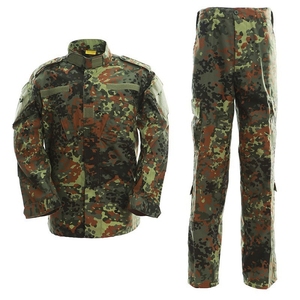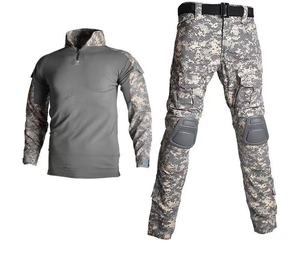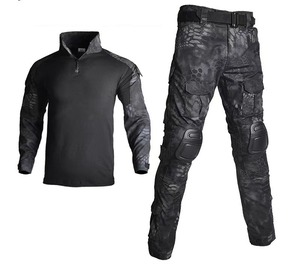(31998 products available)




















































































































































































The US Navy uniform has several types for different functions, events, and representations. Uniforms are practical, ensuring the sailors' efficiency, safety, and identity within and outside the Navy framework.
As such, these uniforms are divided into varied groups as discussed below.
This uniform was made to be worn by the Navy personnel during formal occasions. Normally, it comprises a blue coat and pants with a white shirt and tie. This uniform is a staple in ceremonies, interviews, and official gatherings.
The service khaki uniform comprises a khaki shirt and pants, which are worn mainly in situational places. Enlisted personnel's wears have permanent press pleats in the shirt pocket and on the shoulders. Commissioned officers have ranks embroidered in metal on the epaulets. The uniform is worn by naval officers and is identifiable through a khaki service coat, which is oftentimes worn over the khaki shirt. It is a combination of a khaki coat and trousers, white dress shirts, and a black tie for subordinates, making it more attractive and formal.
The Navy working uniform (NWU) is the most common attire for all operational tasks. The NWUs normally come in three classes; class one is with no camouflage print, class two with no camouflage print but with an integrated belt and a water-resistant jacket and class three, which is a full camouflage uniform. It is intended for off-duty activities, fieldwork, or mission preparations.
a. The Navy peacoat is one of the most iconic Navy uniforms. It is an outer coat, made of [heavy] wool, having broad-sailor collars, and usually dark blue. The U.S. Navy enlisted personnel wear this jacket during the winter months, and it is well-known for its warmth and longevity.b. NWU Type 3 is designed for better protection against varied environments and is also fixated with a water-repellent feature. It has a woodland camouflage pattern that helps the seafarers hide and withstand military operations on land or near shore in the most common environmental types.
The dress blue uniform is made abruptly to convey a sense of Navy pride and is always associated with events. Sailors wear a legged jumper and trousers made of dark blue wool, featuring white stripes on the sleeves. Dress blues are also accurate representations of naval heritage; there is a requirement that all new sailors learn about the history associated with their attire.
The design of naval uniforms incorporates functionality, tradition, and modern requirements. The serving and aquatic environment pieces consider the active roles performed by Navy personnel.
Various constitutive pieces of the Navy uniforms include:
Commonly, Navy uniforms are made from fabrics that can easily be identified as durable and multi-functional. For example, the working and middle uniforms are mainly made of polyester/cotton blends, making them stronger, more difficult, and resistant to strain and wear. Wool and synthetic fibers are also used on dress uniforms for comfort, appearance, and longevity.
The broad blue is the standard color for most Navy uniforms with a specified white color as a variant. These colors hold deep meanings in Navy symbolism; blue represents the sea while white stands for the purity and peace of the nation. Camouflage uniforms have specific colors to be used in-depth activities.
US Navy uniforms are made to serve highly distinct functions. While formal uniforms, like dress blues, are meant for ceremonies, work uniforms are meant for the versatile aspects of daily duties. Many aspects of the uniforms, such as pockets, belts, and reinforced areas, were integrated to enhance practicality in different environments encountered by Navy personnel.
The most common shoes worn with Navy uniforms comprise black leather boots that offer support and could be worn in working conditions. Dress shoes are also made for formal occasions; they are polished and sleek, made from leather.
Insignia are also attached to naval uniforms. These represent ranks and the type of work the officer has been involved in. The commissioning officer ranks are metallic embroidered on the shoulders with colored patches on the breast pockets, indicating specialty badges or stripes for the enlisted personnel.
As with most military establishments, US Navy uniforms advance and are used for various functions. It applies to practical applicability and the ceremonial preservation of military decorum and tradition.
During working hours, Navy personnel perform most of their duties in their current uniforms. Operations include repairing and maintaining equipment, operating ships and submarines, and planning and executing military missions. These clothes have been designed to make work easier, protect against dangerous situations, and build cohesion among team members.
Combat uniforms are meant to keep Navy personnel safe during military missions. They are made of fabrics that resist tearing and wear. They also have pockets and other fittings, which is why the Navy working uniform has a camouflage pattern that helps personnel blend into different terrains while conducting operations both on land and near shore.
Other events where the Navy uniform dress code is observed include ceremonies such as promotions, graduations, and memorials. These occasions focus on the honor, valor, and spirit of respect for the troops. The dress uniforms are fitted for pure elegance and style, thus representing the Royal Navy. USNA holds formal events, including balls, award dinners, and reunions, where midshipmen wear frocks and whites, imperialized uniforms.
Recruitment is a major function of the US Navy uniforms. They project discipline and pride, inducing potential recruits and the public. The uniforms have made the Navy's unique identity recognizable. When people see uniformed members, they instantly relate to the strength and commitment of the organization concerned.
The design and structure of the Navy dress reflect its cultural heritage. Notably, the Peacoat and Dress Blues have historical references to other naval forces. This makes their legacy and continuity be appreciated by the sailors as well as the public.
Without proper maintenance, the durability, functionality, and appearance of US Navy uniforms can never be guaranteed. Further, there are some standards for these uniforms that help in some of these things.
Uniform inspections are undertaken regularly to ensure all Navy clothing is being worn in fighting trim. Insignia, including rank, specialty, and other uniform elements, need to be in designated placement, prominent, and appropriate condition without wear or tear. There must be no modification on the uniform unless authorized by the command. The personal grooming standard is maintained and described in the uniform guidelines.
US Navy uniforms are superseded by [various] sustained wear and tear, and exposure to the elements. Fire retardants and water repellents wear out, making these uniforms the most tough and protective. The functioning of garments designed for work necessitates immediate replacement once any form of visible damage, fading of color, or loss of shape occurs.
Proper storage of uniforms is one of the ways to prolong their lifespan. Navy uniforms should be hung on a non-sliding hanger so that the uniform does not lose its shape. Dress uniforms, such as Whites, should be stored in a protective covering to prevent dust and other stains.
The US Navy has strict uniform standards that should be observed. They include types of material to be worn, grooming standards, and how uniforms should be worn. Further, the Navy allows certain adjustments, including alterations where necessary, but these modifications do not deviate from the essential uniform appearance.
A1: The US Navy uniforms serve several key functions: they keep the soldiers safe during combat, serve as a venue for public relations recruitment, dress code for ceremonies, and historical preservation, among others. They reflect military efficiency and a strong tradition.
A2: Blue and white are the predominant colors of the US Navy uniforms. Blue symbolizes the sea, while white reflects purity and the spirit of the nation. The work and camouflage uniforms comprise colors that assist them in blending with the surrounding environment, whereas the dress uniform is an emphasis on the blue and white.
A3: Maintenance of the Navy uniforms requires washing in cold water, air drying, and careful ironing. Moreover, cleaning and storage procedures are a preservation uniform.
A4: The current Navy uniforms are made of a Navy working uniform (NWU), dress blues, dress whites, service khaki, and peacoats, with each uniform serving specific duties and occasions.
A5: The cut, color, and purpose of the US Navy uniforms are unique when compared to work and dress uniforms of Army, Air Force, or Marine Corps.